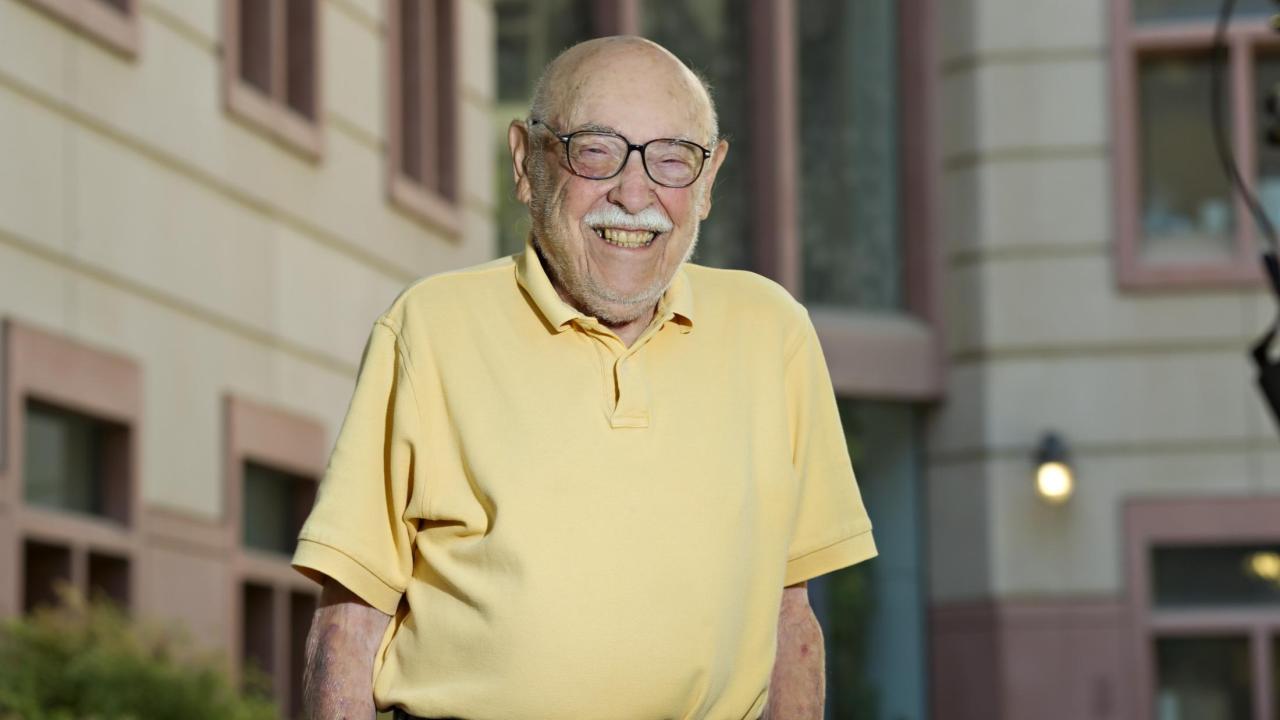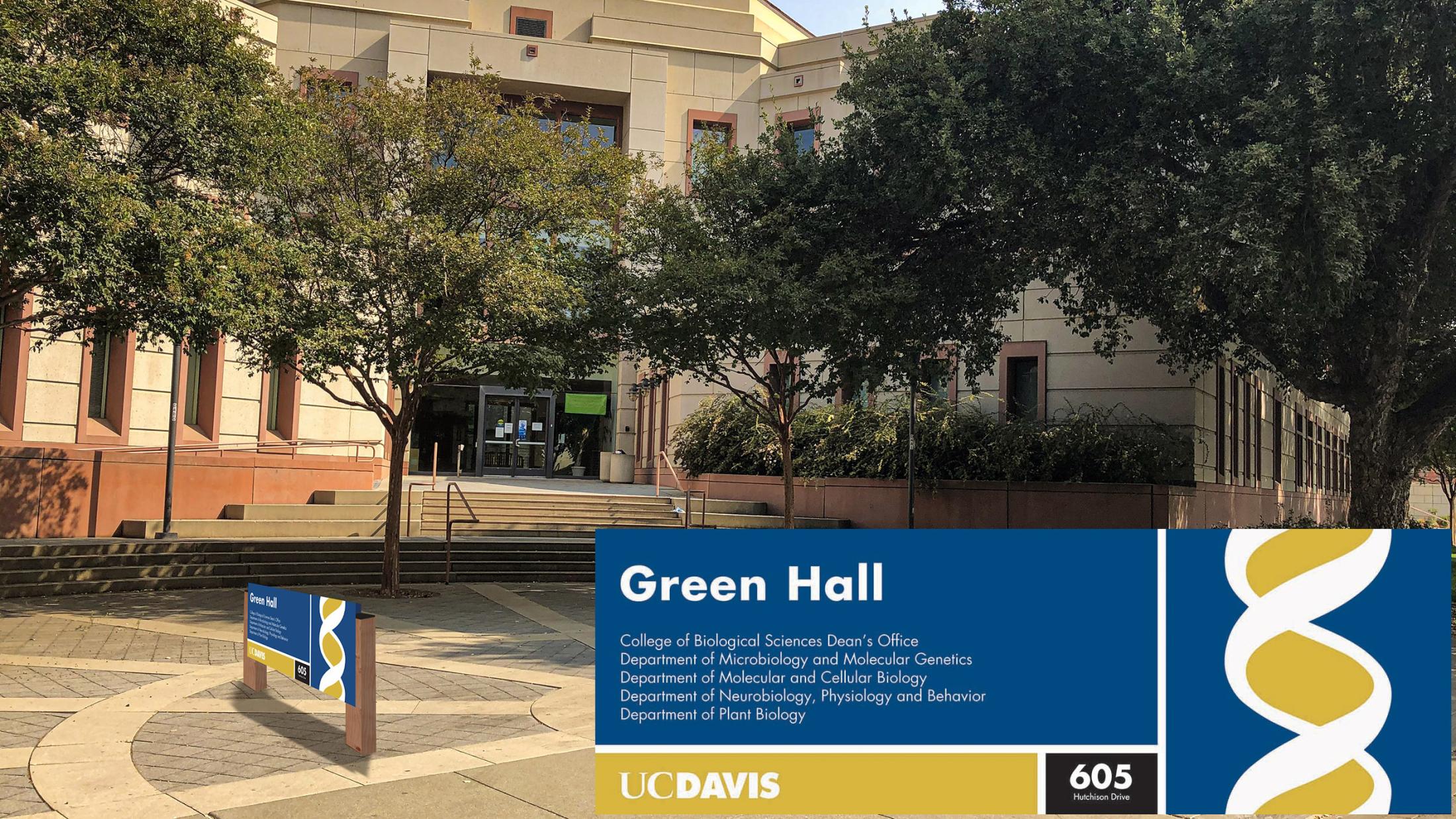
What’s In a Name? Life Sciences to Become Green Hall
Longtime faculty member and wife had ‘amazing partnership’
After 23 years, the Life Sciences building is getting a new name that befits its purpose: Melvin M. and Kathleen C. Green Hall.
The building — which opened in 1997 as an addition to Briggs Hall and houses the UC Davis College of Biological Sciences’ research laboratories, faculty and staff — will honor the late pioneering biology faculty member and his late wife, a biologist and a local politician.
“I think he’d be tickled,” said Ken Burtis, about his friend and mentor, Mel, on having a biology building named for him and his wife. “He’d really get a charge out of it.”

Melvin M. Green
Burtis, who recently retired after a long career at UC Davis, most recently as faculty adviser to Provost Ralph Hexter, worked in a laboratory directly under Mel’s from 1976-79; upon Burtis’ return to UC Davis from graduate school as an assistant professor in 1988, he became Mel’s officemate.
Joking about sharing an office with someone who was hard of hearing and a bit of a curmudgeon, Burtis admitted that Mel “turned out to be an incredibly valuable resource” for both Burtis and generations of biology faculty and students.
“He had two passions,” Burtis said: “Listening to what was going on now (in biology fields), and making sure people remembered the old days.”
Added Professor Dan Starr, “He cared about students more than anybody, (and) even in his 90s, he cared about all of his colleagues. He wanted all of his colleagues to be successful.”
Starr met Mel long after his retirement in 1982 — “I met him in my first faculty reception here in 2003. I knew of him before because I was a grad student in drosophila (fruit flies).” — and admired how the senior biologist put in the effort to get to know you.
“He walked around the offices and showed us journals (relating to our research),” Starr said. “His engagement with science was so genuine.”
Burtis agreed. “The amazing thing is he never lost his curiosity after retirement.”

Kathleen C. Green
As for Kathleen, who also trained as a biologist, Mel would say she was smarter than he and would have made a better scientist, according to Starr.
But, as Burtis explained, “Most germane to her story, (Kathleen was) part of a generation of women who were good scientists in their own right but subordinated their careers” to their spouses’. Which, Burtis added, made her very supportive of young women pursuing science.
In fact, after her death when Burtis was dean of CBS, Mel approached him with his idea to endow a scholarship for women in science in Kathleen’s name. The Kathleen C. Green Scholarship in Biology recognizes the outstanding academic achievements of female biology students.
Kathleen’s influence was especially large in the city of Davis, “when the city was more university-centric,” Burtis said. In 1958, she was the first woman to ever run for Davis City Council, winning a seat and serving until 1962.
She also was charter member of the League of Women Voters in Davis, as well as its president; she served on the Sutter Davis Board of Directors, and she was given the Covell Award, also known as Davis’ Citizen of the Year, in 1971.

Green Hall
And why does it make sense to name a building for the Greens, aside from the fact that having a biology building named “Green Hall” is quite fitting?
Starr offered a couple of reasons.
“(Mel) grew up in the Jewish ghetto in Minneapolis during the Depression,” Starr said. Pre-World War II, he explained, antisemitism was rampant, and finding success was not predestined. “His experience is very parallel to what first-generation immigrants are going through now.”
“To me, it’s more what these two did in their careers: Mel working out of the Jewish ghetto, becoming a war hero, then scientist, (and Kathleen) becoming a great politician.”
— Dan Starr, professor of molecular and cellular biology
Star continued. Mel became a “war hero, (who) took his service to the country very seriously,” working his way up to medical service in France and Belgium.
“Then he had a 60-year career where he was a National Academy of Sciences member,” Starr said with admiration, as well as receiving two Guggenheim fellowships.
“To me, it’s more what these two did in their careers: Mel working out of the Jewish ghetto, becoming a war hero, then scientist, (and Kathleen) becoming a great politician,” Starr said, praising the longterm impacts both made on the campus and city communities.
As well, Starr said, “He is UC Davis. I think the faculty will be thrilled.”
Burtis agreed.
“I think of him as someone who epitomized a lot of the qualities that we most treasure in faculty,” he said: his deep commitment to research and to mentoring the next generation of scientists. “He came to the lab every day until he was physically unable,” Burtis said.
And while there are many “faculty who were worthy” of having a UC Davis building named for them, Burtis added, “You know, Mel, you’re representing 'em all.”

